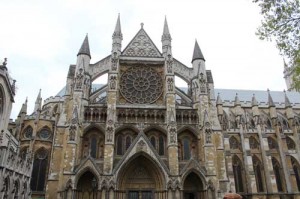 As many of you know, I spent last weekend in London so that I could visit the Tower on 19th May and also see the play Fallen In Love: The Secret Heart of Anne Boleyn. As part of my weekend away, I visited Westminster Abbey on Saturday. I hadn’t been since I was a child, so it was lovely to visit it and pay my respects at the tombs of kings, queens, courtiers, authors and poets who have come to mean a great deal to me. Unfortunately, I can’t share any internal photos as photography was not allowed, but Tim took photos of the exterior and I will give links to online photos of some of the tombs I saw.
As many of you know, I spent last weekend in London so that I could visit the Tower on 19th May and also see the play Fallen In Love: The Secret Heart of Anne Boleyn. As part of my weekend away, I visited Westminster Abbey on Saturday. I hadn’t been since I was a child, so it was lovely to visit it and pay my respects at the tombs of kings, queens, courtiers, authors and poets who have come to mean a great deal to me. Unfortunately, I can’t share any internal photos as photography was not allowed, but Tim took photos of the exterior and I will give links to online photos of some of the tombs I saw.
Arguably the most significant location in Britain, in terms of the Tudor monarchs, the history of Westminster Abbey dates back to over one thousand years. Originally a Benedictine Abbey established by St. Dunstan in the 960s, the Abbey as we know it dates from the reign of King Edward the Confessor. The monastery was surrendered in 1540 as part of the Reformation’s dissolution of the monasteries.
A complete reconstruction of the Abbey was begun in the reign of Henry III in the 13th century, but only completed in 1517 when, under the reign of Henry VIII, the nave was finally finished. In the 1540s the Abbey became the cathedral for the diocese of Westminster, a short-lived change which was ended by the coronation of Mary I and the resurgence of the Catholic faith, which saw a community of monks reside in the Abbey once more. Following the crowning of Elizabeth I, Westminster became a collegiate church with a dean and a chapter of twelve canons. With the exception of Henry VIII, all of the crowned Tudor monarchs are buried in Westminster Abbey.
For those who are interested in the present day Royal family, Westminster Abbey was also the venue for the weddings of Princess Anne, Prince Andrew, the Queen, George VI, Princess Margaret and Prince William & Kate Middleton.
Highlights
- The Coronation Chair – Made on the orders of Edward I in 1300-1301
- The Shrine of St Edward the Confessor
- The tombs of Henry VII and Elizabeth of York, Elizabeth I and Mary I, Mary Queen of Scots, Lady Margaret Beaufort, Henry Carey, Katherine Carey, Anne Neville (wife of Richard III), Anne of Cleves, Charles II, Edward VI, James I and Anne of Denmark, Edward I and Eleanor of Castile, Henry V and Catherine de Valois, Richard II and Anne of Bohemia, and many more.
- The grave of the unknown soldier, which acts as a memorial to all those lost in war.
- Poets’ Corner – See the tombs of Geoffrey Chaucer, Edmund Spenser, Alfred Tennyson and Robert Browning, and memorials to William Shakespeare, Lord Byron, D H Lawrence, W H Audley etc. Famous writers, including Charles Dickens, Rudyard Kipling and Thomas Hardy are also buried there.
- The Pyx Chamber – A low vaulted room dating back to 1070!
- The Chapter House – This octagonal Chapter House dates back to the 1250s and is one of the largest in England.
- Westminster Abbey Museum – The museum has funeral effigies of famous people, including Henry VII, Mary I and one of Elizabeth I, which also includes a beautiful costume.
Although the Abbey was packed with people, so it was hard to pause and think, I still found it moving to visit the tombs of people I had written about. I was struck by the elaborate tombs of the Careys (Henry and Katherine), the grave of the unknown soldier which is decorated by poppies, and the fact that the tomb of Elizabeth I and Mary I is all about Elizabeth, Mary is missing really. The Abbey is beautiful and well worth a visit, just be sure to take your time as there are so many tombs and memorials, and they’re all over the place – on the floor (you can’t help but walk on them), in the walls, in tombs, everywhere!
[slideshow id=541 w=400 h=400]
Links to see photos of tombs:
- Tomb of Elizabeth I and Mary I
- Tomb of Henry VII and Elizabeth of York
- Tomb of Henry Carey, 1st Baron Hunsdon
- Royal Burials at Westminster Abbey